History
How did the Ancient Egyptian Civilisation begin?
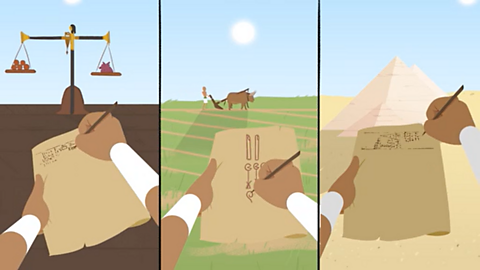
The ancient Egyptian civilisation began 5,000 years ago when people started building villages next to the River Nile in north-east Africa. It lasted for around 3,000 years.
The river was an important source of water in a hot and dry desert landscape. The people were able to grow lots of crops like wheat, barley, fruit and vegetables. They also grew flax to make clothes and papyrus to make paper.
The ancient Egyptians were ruled by kings and queens called pharaohs.

Child: The ancient Egyptian civilisation began 5,000 years ago and lasted 3,000 years!
It was located along the River Nile in north-east Africa. I better write this down!
Oh! I’ve lost my pen.
Ancient Egyptian: You’re clearly not Egyptian, are you?
Child: No, I’m from Britain.
Ancient Egyptian: Haha! No wonder you don’t have a pen. I’m surprised you even know what they are. We’re way ahead of anyone in Britain.
Stonehenge is nothing, compared to these!
Child: Woah!
Ancient Egyptian: What have you got in this linen sack thing anyway? Oh, a calendar! Now that is useful. It’s similar to our own solar calendar which has 365 days in it.
You do have bread at least!
We have some of the most efficient tools for making flour. And we use the River Nile to provide water for our crops. And you’re even using papyrus.
Child: It’s paper actually.
Ancient Egyptian: Well, whatever you call it, we invented it.
We use it to write down our language using small pictures called hieroglyphs.
It’s quite complex, so it takes a scribe like me to do it.
Child: Can you see my pen in there?
Ancient Egyptian: No, which is a shame as record keeping, organisation and planning are key to any successful civilisation.
All these things have helped us become one of the greatest civilisations in world history!
Child: Wow, it’s true what they say. The pen is mightier than the sword.
Ancient Egyptian: Swords have helped a little along the way…
An introduction to ancient Egypt
Bitesize: KS2 History
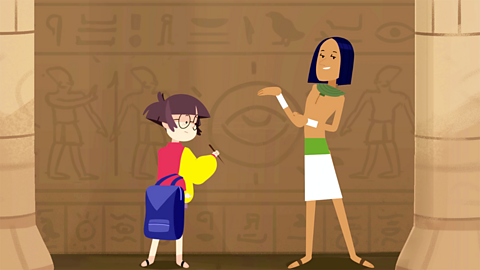
What was life like in ancient Egypt?
Bitesize: KS2 History
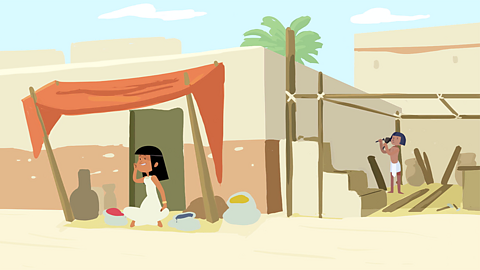
What happened to the ancient Egyptians?
Bitesize: KS2 History
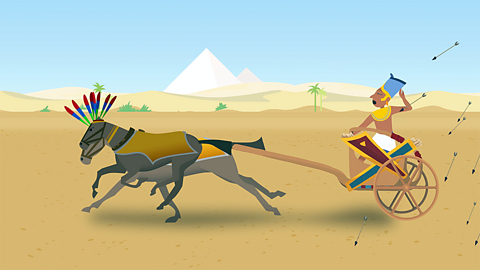
What did the ancient Egyptians believe?
Religion was an important part of ancient Egyptian civilisation. They worshipped over 2,000 gods and goddesses!
They also believed in a never-ending afterlife. They thought it was more important than their life on Earth, so they spent a lot of time planning for their death.
What did the ancient Egyptians believe in?
Bitesize: KS2 History
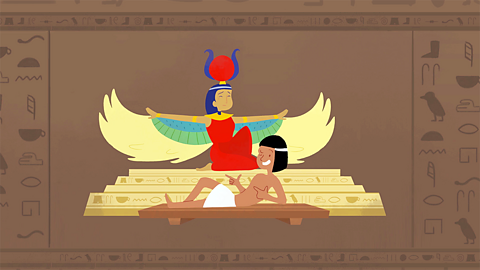
Ancient Egypt - Gods and Goddesses
BBC Teach: KS2 History

Key Vocabulary
| Word | Definition |
|---|---|
| Civilisation | A society of people who live in cities and share ways of living and working. |
| Hieroglyphs | A picture of an object representing a word, syllable, or sound, which is found in ancient Egyptian and other writing systems. |
| Pharaoh | A ruler in Ancient Egypt. |
| Sarcophagus | A large decorative stone coffin in which a dead body was placed in ancient times. Sarcophagi is the plural term. |
| Artefact | A used item from the past that has survived a long time. |
| Canopic jars | A covered jar used in ancient Egyptian burials to hold organs. |
Quiz: Ancient Egypt
Play: History Explorer: Secrets through time
Step back in time and embark on an exciting adventure to explore the wonders of ancient civilisations. In this interactive history game, you'll travel to the heart of legendary societies like Ancient Egypt and the Maya Civilisation. Become an explorer, archaeologist, or ruler as you solve puzzles, collect fact cards, and unlock secrets of the past.
You can also take on the battlefields of World War I. Move through the trenches, discover life in wartime Britain and take part in the Christmas Day Truce.
Are you ready to uncover the mysteries of the past and make history come alive? Your adventure through time begins now!
History Explorer: Secrets through time
Explore the Ancient Egyptian civilisation as well as other eras in the KS2 History Explorer game.
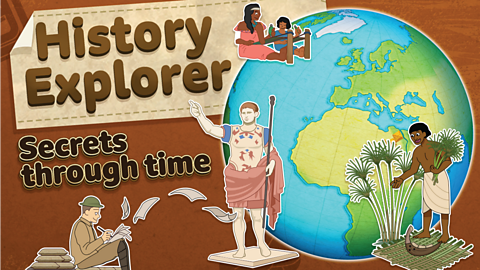
Design and Technology
The Pyramids

The ancient Egyptians were great inventors and builders. They are known for building giant pyramids.
The pyramids are giant structures. Each side is triangular, and they meet in a point at the top. They were built as tombs for pharaohs. The most famous is the Great Pyramid of Giza at 480 feet high which was made from 2.3 million large blocks.
The Great Pyramid of Giza is around 4,600 years old. It was the tallest human-made structure in the world for 3,800 years.
After it was finished, it was covered in white limestone. There were three chambers and two entrances. However, the inside was looted (robbed) and nothing remains except for some large sarcophagi (coffins) of the early pharaohs.

Ancient Egypt - Pyramids
BBC Teach: KS2 History
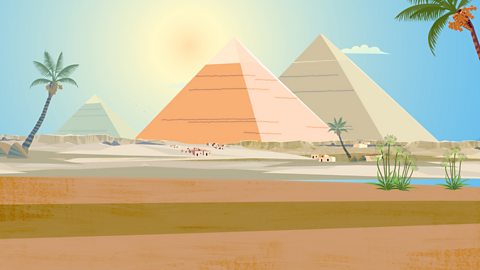
Ancient Egypt - Rames - The Engineer
BBC Teach: KS2 History
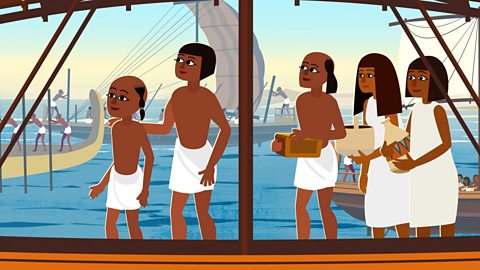
Activity: Make your own pyramid
Make your own pyramid treasure tomb. documentMake your own pyramid treasure tomb
Download our pyramid treasure tomb template. Follow our step-by-step guide to make your own pyramid. What secrets will you bury inside?

Discover more about how to build safe and strong structures.
Strengthening complex structures
Bitesize: KS2 Design and Technology
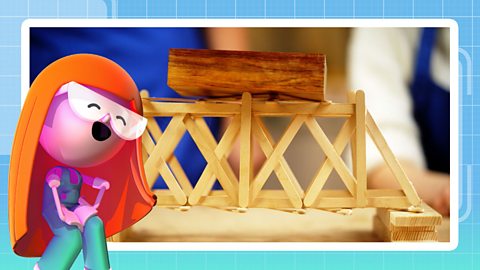
Frame and shell structures
Bitesize: KS2 Design and Technology

How to make a structure stronger
BBC Teach: KS2 Design and Technology skills
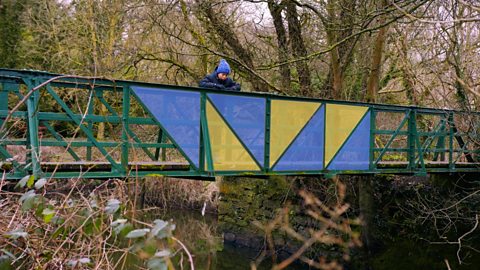
English
Tutankhamun
Tutankhamun became Pharaoh when he was 9 years old and is one of Egypt's most famous rulers.
He died when he was 18, and was buried in the Valley of the Kings.
In 1922, the Egyptologist Howard Carter discovered Tutankhamun’s tomb. In 1923, the tomb was finally opened. There were 5,398 items, including his famous golden death mask.
Howard Carter wrote a diary documenting his findings. Watch the BBC Teach video below.
This is an artefact from Ancient Egypt. It's called a shabti and this little statue tells us about the beliefs and rituals of the AncientEgyptians.
Shabti were buried in tombs with important members of Egyptian society.
They were made holding little tools, so they'd look like mini servants and agricultural workers and that's because the people at the time believed that the statues would come to life in the afterworld and do all the work that was needed.
In 1922 - after searching for six years - a team led by the British archaeologist, Howard Carter, discovered the tomb of King Tutankhamun.
And inside they found more than four hundred shabti.
In total, there were over 5 000 objects in that tomb which took eight years for Carter and his team to remove and catalogue.
The tomb had four chambers, each filled with a huge range of objects including gold jewellery, chariots, model boats, a tiny thrown and paintings.
One of the most amazing items was King Tutankhamun's golden mask, which weighed a whopping ten kilograms and was found on his mummified body in the innermost coffin.
Tutankhamun became pharaoh around 1333 BC and ruled for about ten years. We know he was eighteen whenhe died, so that tells us he was only eight when he became the pharaoh.
Inside his tomb the archaeologists found child-sized thrones as well as games and puzzles all helping to tell the story ofthe child pharaoh ruling over his kingdom.
King Tutankhamun: I win! Now I want a snack.
Recent scans of the mummified remains of Tutankhamun help us to understand what he looked like when he was alive.
They show that he was born with a misshapen left foot and a twist in his spine. So he used sticks to help him walk.
Lots of those sticks were found in his tomb. We also learn about the pharaoh from tomb paintings and carvings on temple ruins.
It appears that Tutankhamun and his dad Aktenaten and did not agree on their favourite god.
So when Tutankhamun became pharaoh, he set about changing all things Aten to all things Amun starting with his own name - and moving on to demolishing his father's prized temple and even moving his body from the sacred ground of Aten to the sacred ground of Amun.
Tutankhamun was reported to have had a wicked temper.
Paintings in the tomb of General Horemheb, who later became pharaoh himself, recorded that he was the only one brave enough to talk to Tutankhamun when he was angry.
King Tutankhamun: Oh it's not fair, get out of my way I'm the king!
From mummified body, personal items and paintings inside Tutankhamun's tomb we learn a lot about his life, but we also learnabout his death.
Scans of his mummified remains show that shortly before his death he broke a bone in his left leg.
This, along with damage to his ribcage led some experts to believe he was killed in a chariot crash or perhaps even a hippopotamus attack. What a way to go!
But experts now think it was more likely to have been a fall.
Today King Tutankhamun is one of the most famous Ancient Egyptian pharaohs, mostly thanks to the determination andpersistence of Howard Carter.
Carter and his team unearthed an ancient tomb, so full of artefacts that it transports us back over 3 000 years, bringing to life another world, where the child king ruled.
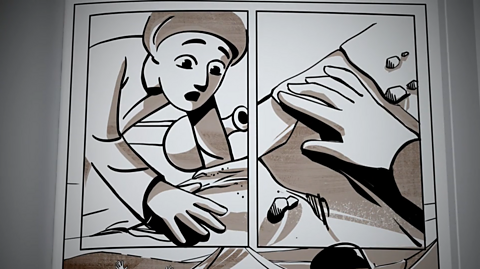
Tutankhamun's tomb
Follow 12-year-old Hussein Abdul-Rasoul, a water carrier who worked at Howard Carter's excavations in 1922 and find out how he helped discover the first step leading to the tomb.
Hussein said in later life that he uncovered the very first step leading to the tomb and, although Carter's diaries do not confirm this be the case, most people think it is most likely true.

Hussein: Welcome to The Valley of the Kings. In this valley archaeologists have found more than 60 tombs were Ancient Egyptian pharaohs and members of their royal families were buried.
The royal tombs are decorated with stories of Egyptian mythology that tell us about the beliefs of the people who lived here more than 3 000 years ago.
I'm Hussein and it's my job to bring water to the site of a new discovery in the middle of the valley.
The team are led by a British man called Howard Carter. They've uncovered a few small tombs before now. This latest one seems to be different.
They say it's the tomb of a pharaoh called Tutankhamun and it doesn't look like this one has been badly disturbed by robbers, so most of the precious items should still be inside.
There are rumours of a curse on this tomb, so I'm keeping my distance. But I was there the day they made a big discovery.
In fact, it was me that found it! I stumbled right on it!
That Saturday morning I arrived on site as normal and started to set up beside the first tent.
I always dig holes in the sand to make the water jars sit upright, but that day when I was brushing the sand away I noticed a stone that looked smooth and different from the other rocks around.
I ran to tell one of the workers and before I knew it Mr Carter was clearing the area and instructing his team.
It didn't take them long to uncover the full stone and realise that it stepped down to another one just like it.
I was staying back out of the way, but I heard them say it looked like the start of a staircase.
There was a lot of excitement as they discovered that the steps lead to the sealed entrance of a tomb and a door marked with the seal of King Tutankhamun.
From what I hear the first room was filled with rubble and broken pieces of jars and pots. But last Sunday they found a second sealed doorway inside the first chamber. Mr Carter himself made a small hole in the doorway and lifted his candle to look in.
It was as if everybody was holding their breath.
Not one sound could be heard until another British man called Lord Carnarvon broke the silence to ask Mr Carter if he could see anything…
Howard Carter: Yes wonderful things…wonderful things!
Hussein: This is as far as I go. Through there is where the pharaoh's mummy was found and I don't want to risk the curse.
Howard Carter: The team have just started the removal and cataloguing of the finds, which could take us many years as there might be as many as 5 000 items in here.
Hussein: That's a ushabti.
The pharaoh's tomb was full of these little statues. They would normally have been of a servant or farm worker.
Do you see the little tools they're holding? Well that's because Ancient Egyptians believed the statue would come to life in theafterworld and then do any work that was needed.
Here they come! I better get back to work!
Key Vocabulary
| Word | Definition |
|---|---|
| Excavation | Removing earth to find artefacts buried in the ground to discover things about the past. |
| Egyptologist | A person who studies the language, history and culture of Ancient Egypt. |
| Valley of the Kings | An area near the River Nile in the ancient Egyptian city of Thebes (part of modern day Luxor) where many pharaohs were buried. |
Activity: Write a diary entry
Imagine you have just made a major discovery in Egypt like Howard Carter or Hussein. Write a diary entry about what you have found in the Valley of the Kings.
Think about the day you made the discovery. What did you see? How did it feel? Can you describe the sounds and smells?
Write in the first person. When you write in the first person, you put yourself inside the writing by describing how you felt and what you were doing.
How to write in the first, second or third person
Bitesize: KS1 English

Play Bitesize Primary games. gamePlay Bitesize Primary games
Fun and educational primary games in science, maths, English, history, geography, art and design, computing and modern languages.

